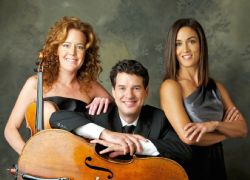|
Symphony
SRS SEASON ENDS WITH RESOUNDING TA-TA-TA-BANG
by Terry McNeill
Sunday, June 1, 2025
Symphony
YOUTHFUL VIRTUOSITY ON DISPLAY AT USO'S MAY CONCERTS
by Peter Lert
Saturday, May 17, 2025
Symphony
MYSTICAL PLANETS AND LIVELY GERSHWIN ORTIZ AT FINAL SRS CONCERT
by Peter Lert
Sunday, May 4, 2025
Symphony
VSO'S CONCERT MUSIC OF TIME, MUSIC OF PLACE
by Peter Lert
Sunday, April 27, 2025
Choral and Vocal
VOCAL ELEGANCE AND FIRE AT THE 222'S RECITAL APRIL 26
by Pamela Hicks Gailey
Saturday, April 26, 2025
CANTIAMO SONOMA SINGS AN INSPIRED GOOD FRIDAY MOZART REQUIEM CONCERT
by Pamela Hicks Gailey
Friday, April 18, 2025
DRAMATIC SHOSTAKOVICH SYMPHONY CLOSES PHILHARMONIC'S 25TH SEASON
by Terry McNeill
Sunday, April 13, 2025
LARGE COLLEGE OF MARIN AUDIENCE GREETS STOPHER ARTISTRY
by Terry McNeill
Saturday, April 5, 2025
Chamber
FRISSON DELIVERS SHIVERS OF DELIGHT
by Abby Wasserman
Sunday, March 30, 2025
OLD AND MOSTLY NEW IN SRS MARCH CONCERT IN WEILL
by Peter Lert
Saturday, March 22, 2025
|
 |
 Lincoln Trio |
LINCOLN TRIO IN RARE WORKS AT OAKMONT CONCERT
by Terry McNeill
Thursday, March 10, 2016
Chicago’s Lincoln Trio returned for a fifth time to Oakmont’s Berger Auditorium Concert Series Mar. 10 with a challenging and uncommon program that began with Rebecca Clarke’s Trio from 1921.
Starting a concert with this formidable work seemed risky, not because of the Oakmont audience but simply for the demands of the music, often acerbic involving a central powerful and knotty idea in all three movements. The Lincoln jumped into the fray with an opening movement and captured the misterioso character and the somber opening movement ending. It’s scary in places and only sometimes sounds like Ravel. The Lincoln played the long lines in the Andante slowly with attention to the phrase endings, with violinist Desirée Ruhstrat’s elegantly stating the first subject with a single G note in the piano part.
In the finale string pizzicato and a hammered piano line led ultimately to excellent ensemble and even a quasi-happy ending.
Stretching the first half was a short transcription of the Irish Ballad “Danny Boy,” a popular and syrupy song from about1910. It was a charming addition to the program and chastely played.
Before intermission the Primavera Porteña movement of Piazzolla’s Four Seasons of Buenos Aires was played.
The Argentinian composer has enjoyed startling popularity in the past decade, and his tango-infused music appears often in chamber music events. Here the offbeat accents, repeated sforzando chords from pianist Marta Aznavoorian and the leaning into phrases seemed a little familiar. The constant tempos changes were deftly handled. The performance seemed to underscore Piazzolla’s swaggering music as initially fetching but finally not memorable.
Turina wrote four substantial piano trios, the two big ones played in recent years by the North Bay’s own Trio Navarro. In a surprise the Lincoln brought out a nearly unknown early trio by the Spanish master, in F and composed about 1905. In a way they own the work, and it was a performance replete with fire, drive and occasional lyricism. The Trio was able to blend a bit of Spanish flavor with something that might have been heard in a Parisian street hall concert prior to the 1914.
Long descending piano runs and charming thematic projections were heard in the first two movements, so different from the trios that just preceded the F Major, by Dvorak, Brahms, Rubinstein, Tchaikovsky and Smetana. Here and there are hints of the dance hall and the palm court. The Lincoln was light footed throughout, especially the surprising momentum in the exciting finale. Cellist David Cunliff played forcefully and supported with gusto the music’s momentum.
A standing ovation produced one encore, Juan Antonio Cucular’s In Conversations. Mr. Cunliff announced it as a wild and crazy piece, and it was that – rhythmically complex, Ginastera like, with spicatto bowing and piano glissandos. Not spooky, just frenzied, and the 175 in Berger loved it.
|
